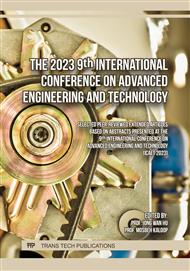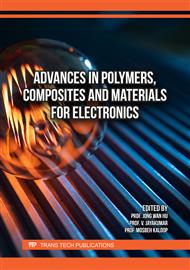[1]
G. D. Goh, Y. L. Yap, H. Tan, S. L. Sing, G. L. Goh, and W. Y. Yeong, "Process–structure–properties in polymer additive manufacturing via material extrusion: A review," Critical Reviews in Solid State and Materials Sciences, vol. 45, no. 2, pp.113-133, 2020.
DOI: 10.1080/10408436.2018.1549977
Google Scholar
[2]
T. D. Ngo, A. Kashani, G. Imbalzano, K. T. Nguyen, and D. Hui, "Additive manufacturing (3D printing): A review of materials, methods, applications and challenges," Composites Part B: Engineering, vol. 143, pp.172-196, 2018.
DOI: 10.1016/j.compositesb.2018.02.012
Google Scholar
[3]
G. L. Goh et al., "Additively manufactured multi-material free-form structure with printed electronics," The International Journal of Advanced Manufacturing Technology, vol. 94, pp.1309-1316, 2018.
DOI: 10.1007/s00170-017-0972-z
Google Scholar
[4]
B. Shaqour et al., "Gaining a better understanding of the extrusion process in fused filament fabrication 3D printing: A review," The International Journal of Advanced Manufacturing Technology, vol. 114, pp.1279-1291, 2021.
DOI: 10.1007/s00170-021-06918-6
Google Scholar
[5]
V. Shanmugam, M. V. Pavan, K. Babu, and B. Karnan, "Fused deposition modeling based polymeric materials and their performance: A review," Polymer Composites, vol. 42, no. 11, pp.5656-5677, 2021.
DOI: 10.1002/pc.26275
Google Scholar
[6]
G.L. Goh, H. Zhang, T.H. Chong, and W.Y. Yeong, "3D printing of multilayered and multimaterial electronics: a review," Advanced Electronic Materials, vol. 7, no. 10, p.2100445, 2021.
DOI: 10.1002/aelm.202100445
Google Scholar
[7]
E. Brancewicz-Steinmetz, J. Sawicki, and P. Byczkowska, "The influence of 3D printing parameters on adhesion between polylactic acid (PLA) and thermoplastic polyurethane (TPU)," Materials, vol. 14, no. 21, p.6464, 2021.
DOI: 10.3390/ma14216464
Google Scholar
[8]
M. Ribeiro, O. Sousa Carneiro, and A. Ferreira da Silva, "Interface geometries in 3D multi-material prints by fused filament fabrication," Rapid Prototyping Journal, vol. 25, no. 1, pp.38-46, 2019.
DOI: 10.1108/rpj-05-2017-0107
Google Scholar
[9]
F. Tamburrino, S. Graziosi, and M. Bordegoni, "The influence of slicing parameters on the multi-material adhesion mechanisms of FDM printed parts: An exploratory study," Virtual and Physical Prototyping, vol. 14, no. 4, pp.316-332, 2019.
DOI: 10.1080/17452759.2019.1607758
Google Scholar
[10]
R. Freund, H. Watschke, J. Heubach, and T. Vietor, "Determination of influencing factors on interface strength of additively manufactured multi-material parts by material extrusion," Applied Sciences, vol. 9, no. 9, p.1782, 2019.
DOI: 10.3390/app9091782
Google Scholar
[11]
C. Rodriguez, H. Narahara, H. Koresawa, N. Hisayuki, S. Akimitsu, "Enhancement of Electrically Conductive FDM Parts Adhesion Strength to Different Polymers through Atmospheric Pressure Plasma Treatment," in Proceedings of JSPE Semestrial Meeting 2017 JSPE Spring Conference, 2017: The Japan Society for Precision Engineering, pp.1025-1026.
Google Scholar
[12]
L. Penter, J. Maier, B. Kauschinger, T. Lebelt, N. Modler, and S. Ihlenfeldt, "3D printing technology for low cost manufacturing of hybrid prototypes from multi material composites," in Production at the leading edge of technology: Proceedings of the 10th Congress of the German Academic Association for Production Technology (WGP), Dresden, 23-24 September 2020, 2021: Springer, pp.396-405.
DOI: 10.1007/978-3-662-62138-7_40
Google Scholar
[13]
C. C. Rodriguez, H. Narahara, H. Koresawa, and H. Nakatani, "The Effect of Atmospheric Pressure Plasma on Inter-Laminar Adhesion Strength of FDM Parts Manufactured with Different Functional Polymers," in Proceedings of JSPE Semestrial Meeting 2019 JSPE Spring Conference, 2019: The Japan Society for Precision Engineering, pp.519-520.
Google Scholar
[14]
N. Kwon, H. Deshpande, M. K. Hasan, A. Darnal, and J. Kim, "Multi-ttach: Techniques to Enhance Multi-material Attachments in Low-cost FDM 3D Printing," in Proceedings of the 6th Annual ACM Symposium on Computational Fabrication, 2021, pp.1-16.
DOI: 10.1145/3485114.3485116
Google Scholar
[15]
G. L. Goh et al., "A 3D Printing-Enabled Artificially Innervated Smart Soft Gripper with Variable Joint Stiffness," Advanced Materials Technologies, vol. 8, no. 24, p.2301426, 2023.
DOI: 10.1002/admt.202301426
Google Scholar



